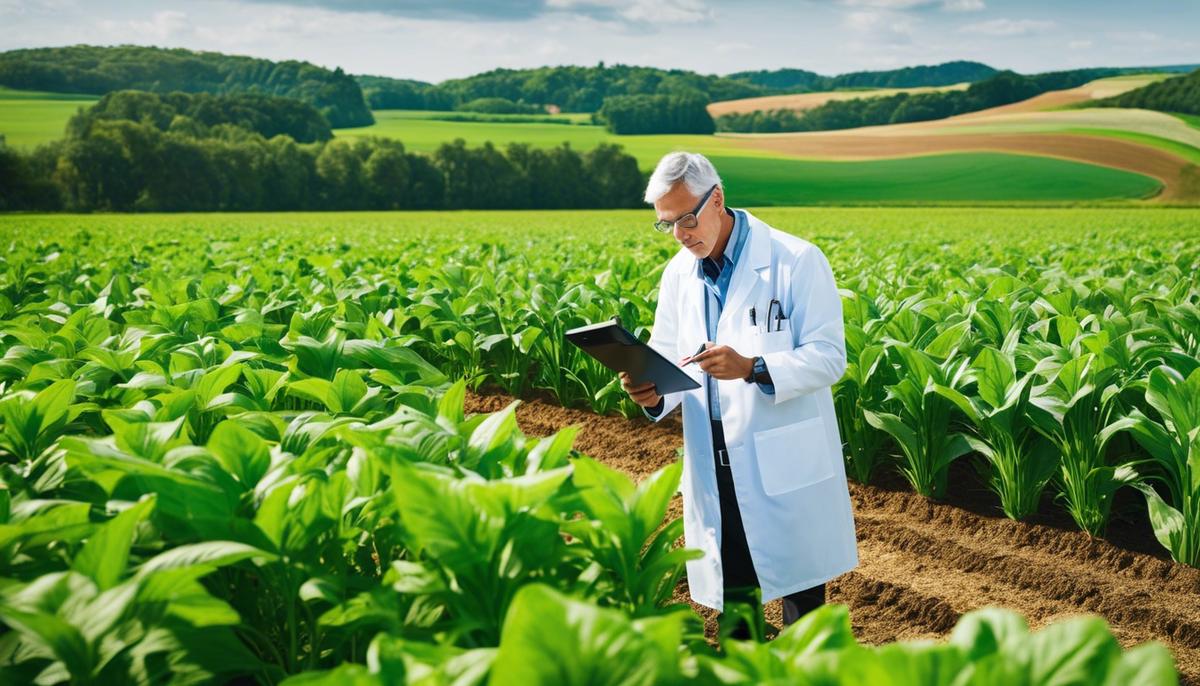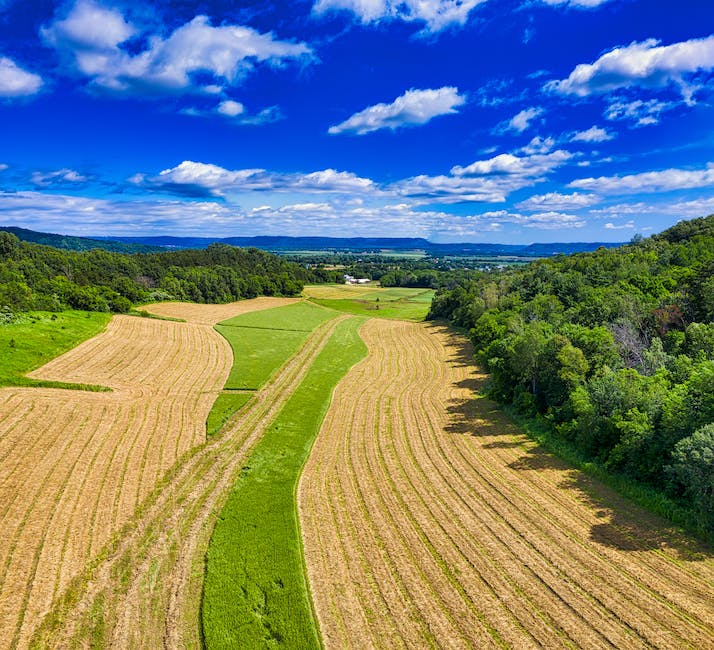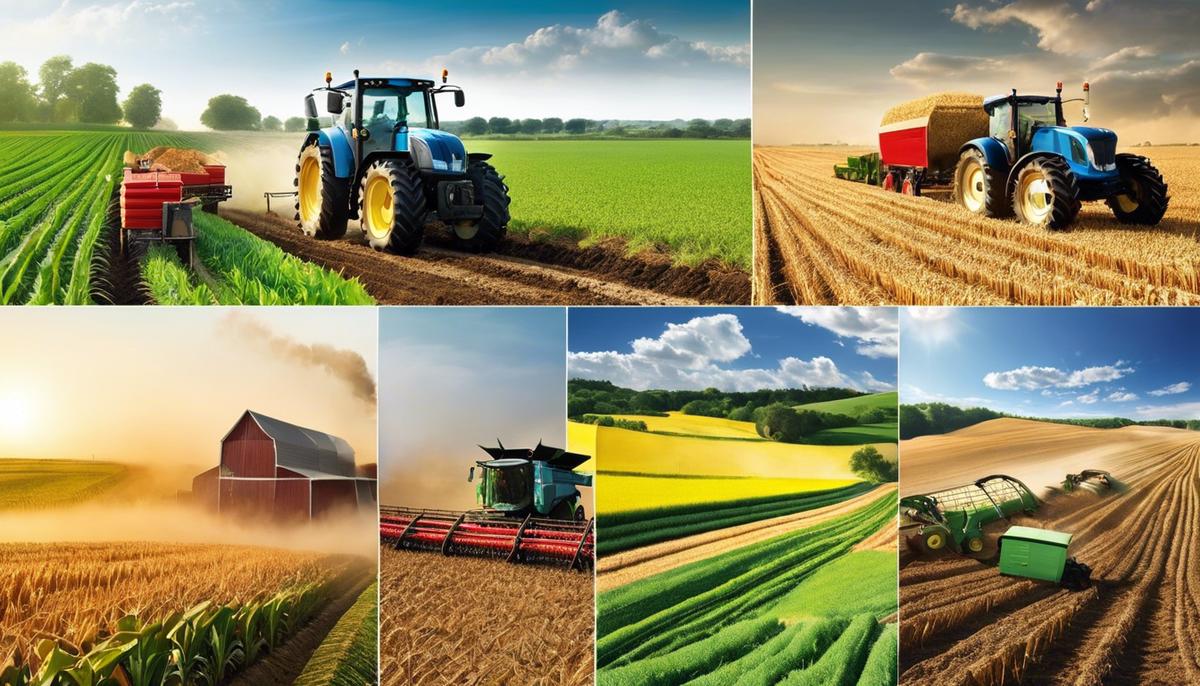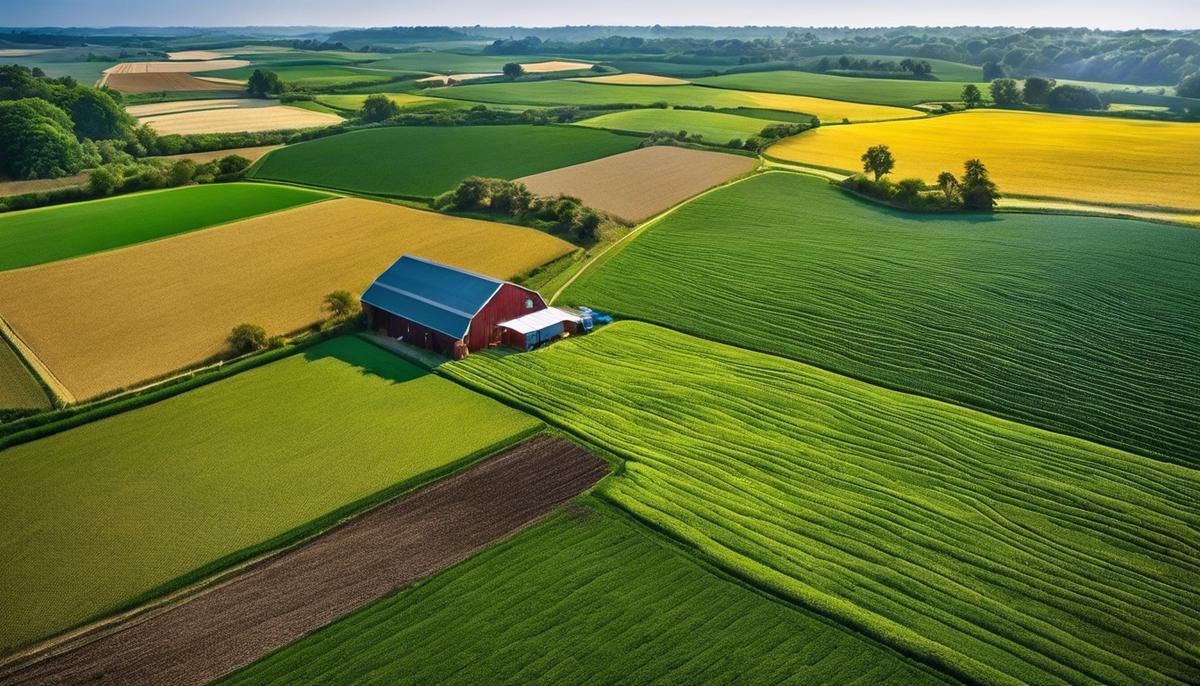
Agriculture science definition
Description: The fabric of human civilization is irrevocably intertwined with the art and science of agriculture. From the domestication of plants and animals thousands of years ago to the advanced mechanized farming of today, the progression of agricultural science has been pivotal in shaping our world. As we venture into this exploration, we will uncover the foundational principles that have been the bedrocks of agronomy, soil science, and genetic breakthroughs. We will navigate through the transformative waves brought forth by cutting-edge technologies that promise to redefine the very nature of farming. By immersing ourselves in this journey, we gain not only an understanding of sophisticated agricultural systems but also of the crucial balance they maintain with nature's delicate ecosystems, all in the ceaseless pursuit of safeguarding humanity's sustenance. Abstract: In the pursuit of satisfying the ever-increasing global demand for food, modern agricultural science stands as a testament to human innovation and dedication. At its core, this field is sustained by interdisciplinary approaches that draw from biology, ecology, technology, economics, and social sciences. This article endeavors to dissect the fundamental components that constitute the contemporary bedrock of agricultural science. Agriculture, one of the oldest human endeavors, has evolved into a complex and diverse field directed by scientific principles. Today's challenges, including climate change, population growth, and resource depletion, demand an increasingly sophisticated and evidence-based approach to crop production and resource management. The intricate tapestry of modern agricultural science is woven from multiple threads of foundational knowledge and innovative research that collectively ensure the sustainability and resilience of food systems. The genesis of agricultural science lies in understanding the genetic makeup of plants. Revolutionary progress in genetics and plant breeding has facilitated the development of crop varieties that boast superior yields, nutritional quality, and resistance to diseases and pests. Advancements in biotechnology and genetic engineering promise further enhancements, albeit entwined with complex ethical and regulatory considerations. Soil, the physical and biological foundation upon which agriculture is built, embodies not just a growth medium but a complex ecosystem vital to plant health. Soil science informs the management of soil fertility and structure, leading to the judicious use of fertilizers and amendments. A profound comprehension of plant nutrition and soil chemistry is imperative to optimize input efficiency, thereby reducing environmental impacts and conserving valuable resources. Agronomy, the applied aspect of agricultural science, synthesizes knowledge of plant genetics, soil science, and ecology to guide crop management practices. Strategic planning encompassing crop rotation, tillage practices, and pest management is indispensable for maintaining soil health and minimizing negative ecological consequences. Precision agriculture, leveraging sensors and data analytics, represents the cutting edge of resource optimization. The emergent challenge of sustainability necessitates an ecological perspective that emphasizes the preservation of biodiversity, soil and water conservation, and the maintenance of ecosystem services. Cover crops, intercropping, and agroforestry are examples of practices that reflect the principles of ecological agriculture, promoting resilience and stability in food production systems. Economic forces and policy frameworks exert a profound influence on agricultural systems. The intersection between economics, subsidy structures, and trade policies, directly affects food production, distribution, and access. Research in agricultural economics is essential to shape policies that support equitable global food security while fostering sustainable practices. The bedrock of modern agricultural science resides not in isolation within a single discipline but emerges from the synthesis of many, forming a robust and responsive foundation for confronting the challenges of feeding a burgeoning global populace. The holistic approaches and innovations continuously advanced by dedicated researchers offer a mosaic of solutions critical for the future of agriculture. The stewardship of this knowledge and the strategic implementation of its associated practices maintain the impetus for ongoing agronomic development and represent the vanguard of a food-secure future for humanity. The advent of precision agriculture heralds a new era in the field of agricultural science, characterized by an unprecedented level of efficiency and accuracy in crop production and farm management. This transformative approach to agriculture integrates advanced technologies such as geographic information systems (GIS), global positioning systems (GPS), remote sensing, and the internet of things (IoT) to cultivate crops in a more controlled and informed manner. The cornerstone of precision agriculture is data – vast quantities of it. With sensors deployed across fields, farmers can now monitor micro-variations in environmental conditions, such as soil moisture, nutrient levels, and pest pressures. Effectively, this information paves the way for the application of “site-specific” management practices, enabling farmers to tailor their strategies to the needs of particular areas within their fields, rather than a one-size-fits-all approach. Automated machinery plays a pivotal role in this technological revolution. State-of-the-art tractors and implements, equipped with GPS and real-time data analytics, can perform field operations with near-surgical precision. Variable-rate technology (VRT), for example, allows for the targeted application of inputs like fertilizers and pesticides, reducing waste and environmental impact, while optimizing yield. One cannot discuss the technological revolution in agricultural science without mentioning the surging use of unmanned aerial vehicles (UAVs), or drones. These flying sentinels offer a bird's-eye view of crops, providing detailed imagery that enables early detection of issues such as water stress, diseases, and nutrient deficiencies. When combined with advanced algorithms and artificial intelligence, drone data can be translated into actionable insights that fine-tune field management decisions. Furthermore, the integration of big data and predictive analytics into agricultural operations is reshaping how researchers and farmers understand and respond to the myriad factors affecting crop performance. Predictive models can forecast weather patterns, pest outbreaks, and market trends, allowing farmers to strategically plan and react to future scenarios, enhancing both resilience and profitability. Technology's influence extends beyond production, permeating the entire agricultural value chain. Blockchain technology, for instance, offers radical improvements in traceability and transparency, essential for ensuring food safety and provenance. Consumers and regulators' rising demand for information on food origin, safety, and sustainability have been met with a technological solution that records and secures each step of the supply process. In conclusion, the technological revolution in agricultural science has galvanized a significant paradigm shift. Precision agriculture is leading to smarter, more sustainable farming practices that conserve resources and optimize outputs. This digital transformation, while still unfolding, promises to meet the ever-growing global food demands in an environmentally conscious and economically viable manner. The role of technology in agriculture is not merely a trend; it is the bedrock upon which the future of farm science is being built. The Imperative of Adopting Climate-Resilient Agriculture The burgeoning global population, allied to the multifarious and intricate implications of climate change, poses unprecedented challenges to food security. In the face of such daunting obstacles, agricultural science has not only to continue developing, but also to act precipitously in advancing climate-resilient agriculture (CRA). CRA seeks to transform and reorient agricultural systems to support food security under the new realities of a changing climate. Resilient agricultural practices are pivotal in mitigating climate-induced stress. For instance, the development and implementation of stress-tolerant crop varieties—capable of withstanding extremes such as drought, flood, and salinization—can play a significant role. Breeding crops for resilience not only buffers the effects of climatic aberrations but also preserves yield stability and quality. Water resource management stands as a critical component of CRA, wherein efficient irrigation systems and water conservation methodologies are essential. The conceptualization and deployment of smart water management technologies—aquaponics, drip irrigation, and moisture sensors—help to optimize water usage and minimize wastage, a crucial aspect in areas where water scarcity threatens sustainable agriculture. In exploring the role of agricultural science in addressing food security challenges, it is essential to integrate livestock management. With escalating pressures on land and resources, climatesmart livestock strategies must be promulgated. These include improving genetics for higher productivity and resilience, advancing feeding practices to reduce environmental impact, and enhancing animal health to lower mortality rates and maximize productivity. Moreover, the synthesis of agroforestry practices into agricultural landscapes serves as a bulwark against the vicissitudes of climate change, enhancing both biodiversity and soil health, and providing additional income streams for farmers through the provision of timber, fruit, and other non-crop resources. Crop diversification is yet another strategy that should be considered. Diversifying crop production to include a range of stress-tolerant species and varieties spreads risk and can result in more reliable yields over time. Furthermore, intercropping and crop rotation can improve soil health, reduce pest and disease pressure, and increase farm productivity. Finally, facilitating capacity building and knowledge transfer for farmers is fundamental. Empowering farmers with the essential tools and understanding to implement CRA practices ensures that agricultural advancements are not only theoretically robust but practically applicable. This necessitates a multidisciplinary and collaborative approach involving researchers, educators, extension services, and the farmers themselves. In conclusion, agricultural science is indispensable in the quest to combat global food security challenges. While significant strides have been taken across various domains, the relentless evolution of climate threats requires a continual reassessment and adaptation of strategies. By fostering resilient agricultural systems, fostering innovation, and promoting knowledge exchange, agricultural science plays a crucial role in ensuring an adequate food supply for an ever-growing population, against a backdrop of climatic uncertainty and variability. Abstract: The contemporaneous challenges of escalating global populations and the vicissitudes of climate change have rendered food security attainment an exacting endeavor. Consequently, agricultural science perseveres as the linchpin in crafting sustainable, climate-resilient food systems. The extrapolation of this article elucidates the nexus between agricultural science and environmental sustainability, underscoring strategies like Climate-Resilient Agriculture (CRA), water resource management, and agroforestry integration, amongst others. Within the domain of agriculture, the concept of Climate-Resilient Agriculture (CRA) has burgeoned as a monumental armamentarium against climatic adversities. Connoting the augmentation of agricultural systems to be more impervious to climatic perturbations while concurrently reducing greenhouse gas emissions, CRA emerges as a cardinal stratagem to sustainably meet the nutritional demands of a surging human populace. The deployment of stress-tolerant varieties remains instrumental in shielding crops against the deleterious ramifications of climate-induced stresses. These cultivars withstand drought, salinity, and thermal extremes, thereby ensuring yield stability and ameliorating nutritional content. Amid variable precipitation patterns and heightened evapotranspiration rates, the ingenuity within agricultural disciplines has been directed toward water conservation. Efficient irrigation technologies, like micro-irrigation systems, coupled with water harvesting and recycling practices, have been pivotal in bolstering water use efficiency, thus contributing to the ethos of CRA. The integration of climate-smart livestock management into agricultural systems offers a multifaceted approach, addressing feed efficiency, manure management, and methane reduction. By aligning these practices with broader CRA objectives, a holistic nexus is forged toward agricultural sustainability. Agroforetry practices, with their inherent ability to amalgamate forestry with agriculture, provide a robust defense against climate-related adversities. By enhancing carbon sequestration, bolstering biodiversity, and creating alternative income avenues, agroforestry epitomizes the synergistic confluence of sustainability and productivity. The principle of crop diversification functions as a risk mitigation tapestry within the agricultural mosaic, diminishing dependencies on single-crop systems and fostering a distribution of agricultural risks. This encourages more dependable yields across temporal and spatial vicissitudes. The fortification of farmers through capacity building and knowledge dissemination forms an essential cornerstone of CRA. Empowering farmers with contemporary, evidence-based practices ensures the grassroots implementation of sustainable approaches, thereby upscaling the impact of agricultural science on food security. It stands irrefutable that the advancement of agricultural science in sustaining food security against the backdrop of climate uncertainty necessitates a multi-pronged, collaborative effort among scientists, educators, extension practitioners, and the farmers themselves. Such an interdisciplinary nexus fosters innovation and the articulation of shared, sustainable visions. In perceiving the realm of agricultural science through the lens of environmental sustainability, it is palpable that agricultural science functions not merely as a traditional purveyor of foodstuff but as a sentinel of sustainable livelihoods and ecosystems. The elaborate interplay of CRA strategies, water conservation, agroforestry, diversification, and capacity building, coalesced with a spirit of collaboration, propels us toward a more resilient and ecologically conscientious future. The exigency to tangibly actualize such practices in the face of climate unpredictability is an imperative that agricultural science continues to champion with unwavering commitment. Title: Ethical and Policy Considerations in the Advancement of Climate-Resilient Agricultural Science Abstract: Introduction: Main Body: Ethical considerations in agricultural research are multifarious. The pursuit to incorporate climate resilience into agricultural systems requires a delicate equilibrium between innovation and conservation. The development of stress-tolerant crop varieties, efficient irrigation systems, and integrative livestock management must comport with overarching ecological preservation objectives. The promulgation of climate-resilient agricultural practices harbors a potential to transmute landscapes through the introduction of agroforestry, which dovetails the benefits of biodiversity with sustainable land use. Nonetheless, such endeavors prompt ethical deliberations on land tenure rights, ecosystem services impacts, and the socio-economic ramifications for local communities. Crop diversification strategies serve as risk mitigation mechanisms. However, ethical decision-making must navigate the complexities of crop selection, genetic resource utilization, and cultural considerations. The richly entwined fabric of local agricultural traditions with indigenous knowledge systems invites ethical reflection and respect for bio-cultural heritage. Capacity building and knowledge transfer to farmers are indispensable for the realization of CRA goals. The ethical imperative here is to ensure equitable access to information and technology for all, irrespective of socio-economic status. Policy frameworks must erect robust mechanisms to uphold this equitable distribution and to protect farmer autonomy. Collaboration is the linchpin of advancing agricultural science in the tumult of climate uncertainty. This necessitates a framework of translational ethics, where findings from diverse scientific disciplines converge to inform policy decisions, extension programs, and educational curricula. Conclusion: As agricultural science gravitates towards the nexus of climate resilience and sustainable food systems, ethical and policy considerations ascend in prominence. The integrity of research is maintained by a steadfast commitment to these values. It is incumbent upon the scientific community to steward the evolution of agricultural praxis with judicious ethical reflection and policy guidance, ensuring that the paradigms of tomorrow are rooted in the ethics of equity, sustainability, and resilience. In this mission, the global community is inexorably linked through our common endeavour: to secure a food system capable of withstanding the vicissitudes of a changing climate, in sustenance of an ever-growing human populace. The profundity of the task beckons a rigorous, yet agile approach to scientific inquiry and policy-making within the ambit of agricultural science. The intricate tapestry of agricultural science is more than just a confluence of techniques and theories; it is a testament to human ingenuity and its enduring quest for survival and sustainability. As we have traced the arc of this multifaceted discipline, from the essentials of agronomy to the complexities of policy and ethics, we are reminded that the future of agriculture hinges on our collective responsibility. It demands vigilance against environmental degradation, an embrace of innovation within ethical bounds, and a commitment to nurturing the very soil that feeds us. The symbiosis between people, plants, animals, and technology, harmonizing within the vast, interconnected cycle of life, underpins the very essence of agricultural science and secures its pivotal role in the survival and prosperity of future generations. As we navigate the complexities of the 21st century, the role of agriculture science becomes increasingly paramount in ensuring food security and sustainability. Dating back to early civilizations with basic farming methodologies, agriculture has metamorphosed into a discipline pressed front and center by the scientific community, with remarkable breakthroughs disrupting conventional farming practices on an extraordinary scale. Through the lens of historical context, biotechnological applications, sustainable practices, and the looming climate change threat, this discussion delves into the intricate tapestry of agriculture science. By exploring such pivotal and innovative aspects of our food production systems, we aim to showcase the past, present, and future of this remarkably transformative field. Agriculture holds an unparalleled influence over the course of human history. From the primitive to the present, agricultural practices have undergone vast transformations, shaping not only how civilizations eat, but also how societies develop. This continuous evolution of agricultural science, underpinned by relentless innovation, has been marked by striking milestones that serve as testament to mankind’s ceaseless aspiration to harness the environment in service of survival and progress. The saga of agricultural science commenced nearly 10,000 – 5,000 BC with the globally concerted transition from nomadic hunting and gathering to organized cultivation – a pivotal period referred to as the Agricultural Revolution. This 'revolution' witnessed the domestication of plants and animals, a phenomenon that set the cornerstone for predictable food supply. One cannot underestimate the impact of this shift, as it ignited the building blocks of civilizations, facilitating sedentary settlements, social complexity, and remarkable population growth. Fast-forward some millennia to the 18th and 19th centuries. The world bore witness to the advent of scientific farming, brought forth by the Agricultural Revolution of the Western world. Referred to as the Second Agricultural Revolution, this period saw great leaps in productivity due to enhanced breeding practices, improved crop rotation methods, and the introduction of new machinery. These advances weaved fervently into the fabric of farming as they helped improve food security and sustain burgeoning industrial cities. As the wheel of time spun into the 20th century, there emerged the marvel termed the Green Revolution, which ushered in an era characterized by exponential yields facilitated by novel technologies. This period was marked by the birth of high-yielding variety (HYV) seeds, chemical fertilizers, and advanced irrigation methods. Here, agricultural science allowed for the production of more food per acre than ever before, making vast strides towards eradicating global hunger. This relentless progression has not ceased over time but has only gathered speed in the 21st century. Farmers today implement highly sophisticated precision farming techniques, influenced by data and bolstered by technology. Satellite imaging, IoT devices, and GPS systems now help tailor every aspect of agricultural practices down to individual plants. Throughout this long-spanning journey, agricultural science's continual evolution has shaped and will continue to shape, our world in unforeseen ways. It has not merely responded to the growing demands of a rising global population but has also influenced the transformation of economies, societies, and human lifestyles. Its technological innovations have enhanced the productivity, efficiency, and sustainability of farming practices immensely. Indeed, as agricultural science propels forward, gleaning insights from various disciplines such as biotechnology, engineering, and artificial intelligence, it will continue to redefine farming's landscape. The future of this journey promises fascinating discoveries, challenges to surmount, and the inevitable reshaping of mankind's relationship with nature and food production. It is a testament to the human spirit of curiosity, problem-solving, and ceaseless innovation. The burgeoning field of biotechnology is presently at the forefront of a new agricultural revolution. Building on the fertile ground of previous developments, biotechnology is poised to cultivate profound changes within agriculture, altering not only the nature of food production but the social and environmental landscapes in which it is embedded. Much of the transformative power of biotechnology in agriculture is rooted in its ability to accelerate and enhance traditional plant breeding methods. The advent of genetic engineering allows for the introduction of specified traits into plants with unprecedented precision. This contrasts with the slow and haphazard processes inherent in selective breeding. Through this, biotechnologists can create crop varieties that are resistant to pests, resilient in the face of unpredictable weather, or capable of thriving in poor soils. Just as the invention of the plow or the introduction of high-yield seeds transformed agriculture in their time, so too is biotech promising similar leaps forward. Genetically Modified Organisms (GMOs) for instance, are one manifestation of these advancements. The introduction of Bt cotton, corn and rice, which involves the incorporation of a bacterium gene to lend the plant defense against pests, testifies to a world where GMOs can safe guard food crops against pest infestations. To address the challenges of a growing global population and increasing food insecurity, the biotechnological tool of CRISPR (Clustered Regularly Interspaced Short Palindromic Repeats) is ushering in a new era of possibilities. It offers a means of editing genomes with remarkable precision, paving the way for enhanced crop productivity, nutrient composition, and resilience. The relatively expedient and cost-effective nature of CRISPR technology implies it will be a cornerstone for ensuring global food security in the decades to come. Biotechnology is not only enabling genetic modification but also fostering innovations in the realm of biofertilizers and biopesticides. Utilizing microbes to boost plant health and growth, these tools can significantly reduce the dependency on chemical counterparts, curtailing pollution and mitigating negative impacts on non-target organisms. By marrying biotechnology with sustainable farming practices, a more holistic, eco-friendly approach to agriculture can be pursued. To conclude, the impact of biotechnology on the agricultural landscape is both multi-faceted and momentous. Like a seed becoming a plant, this emergent field holds within it immense potential. As biotechnology continues to evolve, so too will it inevitably cultivate the agriculture of the future. The fruits of this labor will be tasted in not just the higher quality of our crops, but in the preservation of our environment, the prosperity of farmers, and the global fight against hunger. We stand on the threshold of a new agricultural epoch, and biotechnology is the key to its gate. Understanding the scale of agricultural transformations, and the resulting advancements in modern farming, encourages us to step into a new realm - sustainable farming. This arena encapsulates ecological practices that contribute toward a healthier environment. With varying techniques, their core focus is to promote environmental conservation, economic profitability, and social fairness. Crop diversification is a prime example. As a technique, it helps mitigate risks affiliated with weather changes, pests, and diseases by growing different types of crops in one area. Remarkably, it discourages the onset of pests and diseases due to changing food supply for them, whilst improving fertility through natural nutrient recycling. Companion planting also serves the philosophy of sustainable farming. It leverages the benefits of biodiversity by growing complementary crops side by side. In a symbiotic relation, one crop helps enhance the condition for its partner, such as providing shade, replenishing soil nutrients, or repelling pests. It's a momentous display of nature's synergy, simultaneously boosting crop productivity and enhancing ecosystem health. Moving onward, cover cropping is another facet of sustainable practices. Planting cover crops in off-seasons helps improve soil structure, prevents erosion, suppresses weeds growth, and enhances nutrient content. Thus, the soil fertility increases, paving the way for bountiful crop production without adverse environmental effects. In contrast to synthetic inputs, organic fertilizers offer safer and sustainable solutions. They enrich soils without polluting water bodies or deteriorating eco-balance. Composts, cover crops, animal manures are valuable organic materials that improve soil quality and fertility for long term sustainability. Integrated Pest Management (IPM) is a strategic approach that minimizes pesticide use through comprehensive pest management programs. It saves the crops from pests without inflicting harm to natural resources or non-target organisms, an approach honoring both ecological and economical balance. Besides the practices, sustainable irrigation methods, too, ensure efficient use of water. Micro-irrigation, rain harvesting, and other efficient irrigation systems substantially reduce water wastage, lowering the pressure upon water resources. Sited amid innovation, agroforestry is one ground-breaking sustainable practice, integrating trees and shrubs into crop or animal farming systems. Trees act as windbreaks, control erosion, enhance soil nutrients, provide habitat to beneficial insects, and more. It's a creative integration for sustainable food production and environmental conservation. Along with the environmental benefits, sustainable farming practices are economically viable as well. They reduce the dependency on costly synthetic inputs and result in lower operational costs, securing long-term profitability for farmers. Socially too, they instigate the development of communities by ensuring food and livelihood security. Sustainable farming, emerging from the fusion of science and nature delivers the brilliance of agricultural advancements, while preserving the ecological balance. It's a beacon of hope in the discourse of environmental conservation and will continue to evolve its practices in response to the dynamic nature of agriculture and environmental needs. The dance between human innovation and natural wisdom, it seems, has only just begun! Efforts to progress on the bountiful path of civilization have been innately tied to our capacity to harness and alter the environment and its resources. As such, it stands to reason that climatic changes have inherent probable repercussions on agricultural practices, which in turn shape the narrative of human survival and development. Climate change, unequivocally affirmed by a consensus in the scientific community, is of particular concern in this context. Altered weather patterns directly impact crop yields and livestock health, subsequently affecting food production, prices, and access. In a sobering twist of irony, while agriculture is a significant contributor to greenhouse gas emissions, it is also on the front lines of experiencing the severe effects of climate change. An exacerbation in the frequency and severity of cyclones, floods, droughts, and heatwaves prompts tremendous upheaval in farming communities. The alterations in temperature and precipitation patterns have explicit implications for planting and harvesting cycles and could render previously arable land unsuitable for cultivation. Deviant weather patterns also escalate the prevalence and spread of pests and diseases, posing heightened threats to crop productivity and livestock welfare. Sea-level rise threatens fertile coastal farmlands and contaminates freshwater supplies with salt, while escalating temperatures push traditional farming boundaries further poleward. Regions dependent on glacier meltwater for irrigation face the prospect of water scarcity as glaciers recede due to global warming. All these effects are but the tip of a massive iceberg of potential complexities induced by climate change in agro-ecosystem dynamics. The task at hand then is to forge a path that mitigates these impacts, not only to secure current agricultural practices but also to ensure future food security against the backdrop of a burgeoning global population. Definitions of this path often take up the mantra of agricultural adaptation and resilience. Crop diversification, especially planting more climate-resilient crops, for instance, has the potential to buffer farming systems against climatic variability. Another promising tactic is the rotation and intercropping techniques, where planting multiple crop species in the same space can improve soil health, enhance pest and disease control, and increase crop yield. Companion planting also contributes to these benefits while providing a more diverse and nutritious yield. Additionally, the judicious application of organic fertilizers contributes to soil health, and Integrated Pest Management techniques can curtail reliance upon chemical pesticides. Water management practices, namely, the adoption of efficient irrigation systems and watershed management, also hold the potential to conserve water, a resource set to become much more precious in a warming world. Additionally, agroforestry, where trees or shrubs are grown around or amongst crops, can sequester carbon, enhance biodiversity, and improve soil quality. Incorporating these practices does not just fall in line with environmental well-being but can also significantly benefit stakeholders economically and socially. Farmers can reduce costs by adopting effective pest management and water conservation techniques, while healthier soil and more diverse crops can increase yields and therefore profits. Moreover, socioeconomic benefits can transpire through job creation in sustainable farming sectors and better food security communities, as local farming can furnish healthier, diverse, and stable food supplies. Lastly, sustainable farming may well lay the foundation for a future wherein the agricultural community contributes less to environmental degradation and more to its preservation – truly sustainable in every sense of the term. Each of these sustainable farming practices offers a tangible response to the threat climate change poses to agriculture, and their coordinated implementation could help steer the sector towards a more robust, resilient, and sustainable future. As the globe hurtles forward on its warming trajectory, advancing strategies that promote agricultural sustainability becomes not just the need of the hour, but a necessity for survival. Climate change is an impending and urgent reality, but armed with knowledge, innovation, and concerted global effort, it is a reality that can be faced, navigated, and ultimately, to a considerable degree, controlled. As we scrutinize these agricultural science facets and their implications, the significance of this field in dictating the trajectory of our future becomes evident. Equipping us with the tools to manipulate plant genetics, resist diverse threats, and formulate sustainable practices, it stands as an unmistakable testament to human ingenuity. Yet as we push into a future fraught with uncertainties - particularly from climate change - agriculture science must respond with ingenuity to protect our food systems. This reflection only affirms the truth that despite our leaps in understanding and technological advancement, there remains a frontier of knowledge yet to be breached in agriculture science - one that holds promise for a sustainable, resilient, and bountiful future for all.Agriculture science definition
Foundational Principles of Agricultural Science
Introduction:
Genetics and Plant Breeding:
Soil Science and Plant Nutrition:
Agronomy and Crop Management:
Ecology and Sustainable Practices:
Agricultural Economics and Policy:
Concluding Considerations:

Technological Advancements in Agriculture
Precision Agriculture: The Frontier of Farming Efficiency

Role of Agricultural Science in Global Food Security

Environmental and Sustainability Considerations
Agricultural Science: The Vanguard of Environmental Sustainability and Climate-Resilient Food Systems
Climate-Resilient Agriculture: A Paradigm Shift Toward Sustainable Food Security
Stress-Tolerant Cultivars: An Ode to Genetic Innovation
Water Resource Management: The Crux of Agricultural Sustenance
Livestock and Climate-Smart Strategies: An Integrated Perspective
Agroforestry: Cultivating Resilience and Biodiversity
Crop Diversification: A Strategic Move for Risk Aversion
Empowering Farmers: The Quintessence of Agricultural Advancement
A Multidisciplinary Endeavor: Crafting an Interconnected Framework
Conclusion

Agricultural Policy and Research Ethics
The exigencies of climate change and escalating global food demands necessitate a paradigm shift in agricultural research. This discourse delineates the constellation of ethical conundrums and policy constructs that underpin contemporary agricultural science endeavors, with a focal emphasis on augmenting climate resilience within agricultural systems.
In light of the unprecedented alterations in climatic patterns and the amplification of the global population, agricultural science finds itself at an inflection point. The exigency to bolster food security through climate-resilient agriculture (CRA) demands scrupulous ethical consideration and cogent policy frameworks. This treatise explores these imperative dimensions beyond the foundational aspects of plant genomics, precision agriculture, and sustainable agronomic practices.
Agriculture science
Evolution of Agriculture Science
The Ever-Changing Landscape of Agriculture: A Glimpse into its Evolution and Impact

Application of Biotechnology in Agriculture

Sustainable Agriculture Practices
Sustainable Farming Practices: Pillars of a Thriving Environment

Impact of Climate Change on Agriculture
